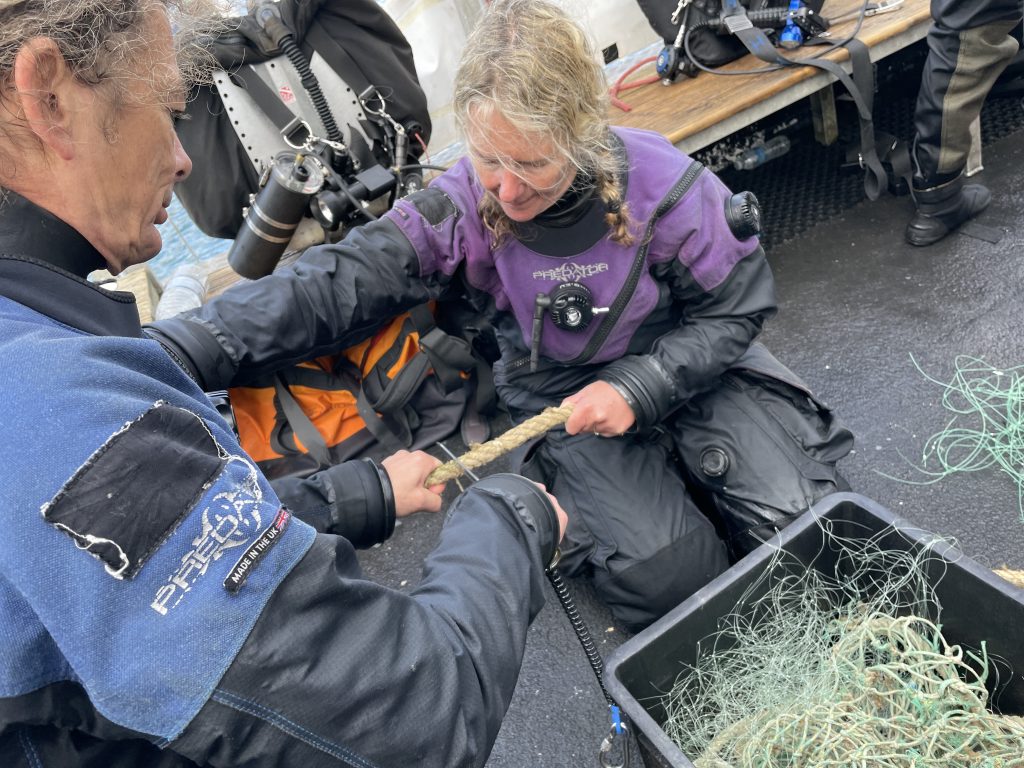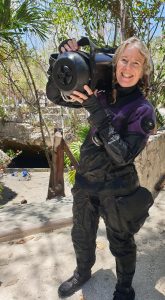Cutting practice. Image: Christine Grosart
What an amazing feeling to see your first lobster pot hurtling towards the surface, writes Andrea Brown, as she remembers her training with Ghost Fishing UK in Plymouth, on England’s south coast. Here she opens up her diary to give an account of the practical elements of the training every Ghost Fishing UK diver needs to go through before they join the team.
Tuesday 27th September 2022
Having completed the course academics over two nights by Zoom, Paul and I were excited to be heading to Plymouth after work. Our Ghost Fishing UK diving course was to start the next morning. We chucked our stuff in our lovely Airbnb and went to the nearby Clovelly pub in Turnchapel, only to be told that we had missed last orders. Paul was not happy to miss his much anticipated beer! We managed to find a pizza shop still open and I saved the day by finding some beers in the shop next door. Then it was back to our Airbnb for beer and pizza overlooking the marina.
Wednesday 28th September 2022
Woke up excited and a bit nervous at the same time. We were to meet the Ghost Fishing UK team at In Deep Diving Centre, Mount Batten, Plymouth. We were chatting to skipper James Balouza when our instructors Fred Nunn and Christine Grosart arrived. We recognised fellow students Sam Brunsdon and George Platten from our Zoom calls. We were all to be with James on the dive boat Seeker – Sam and I were in Team Fred, with Paul and George in Team Christine. Ghost Fishing UK diver Tom Ball was also interning on our course while learning to teach the course himself.
Our first dive in Cawsand was a skills dive. Fred had Sam and me form a triangle to do helicopter turns, backward finning and flutter kicks. These are different propulsion techniques that would enable us to carefully move around ghost gear without using our hands to push off it. We both then sent up ‘delayed surface marker buoys’, which divers use to communicate their position underwater to the surface and so avoid being run over by a boat! This year I have mostly been cave diving, so I was a bit out of practice with the buoy and needless to say mine was a bit pathetically under-inflated on the surface!
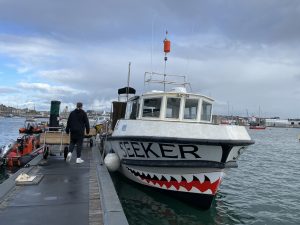 | 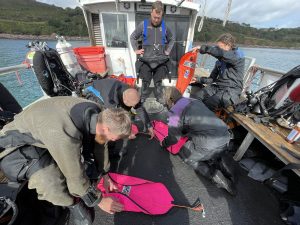 |
Second dive in Cawsand again. Sam and I did an ‘out-of-gas drill’ where we simulate one diver running out of breathing gas and needing to be assisted by a teammate. The first attempt was a little fast. Fred made us do it again and this time it went much better. We then did ‘out-of-gas ascents’, where we donate breathing gas all the way to the surface and include deploying the delayed surface marker buoy to add to the fun! I learnt from this dive that once gas has been donated to the receiver, there is no rush and to slow down and think about what can I do to improve the situation.
After putting in our twinset cylinders for gas fills, we got the ferry over to the Barbican and went for pizza at The Stable. The Barbican was my old stomping ground and I regaled Paul with stories of drunken pub crawls when I was much younger! Christine and I shared a bottle of rosé wine and caught up on all the cave diving gossip. At the end of the evening Christine and Fred said how about a night cap at the Plymouth gin distillery, but it was not to be as the bouncer on the door wouldn’t let us in. We must have looked well dodgy in our Ghost Fishing UK hoodies!
Thursday 29th September 2022
Today was survey day and we were all very excited. Skipper James perhaps less so when he saw the dirty buckie pots, lobster pots, inkwell pots and netting loaded onto his lovely clean boat! We headed to Pier Cellars for our third dive. Fred and Tom chucked the lines of pots, which were to simulate ghost gear, over the side and into the water, one for each team.
Keeping the same teams as yesterday, Sam and I quickly got into a rhythm with me doing the survey and Sam doing the video. As well as sketching it is important to record as much as possible i.e. depth, compass bearing, number and type of animals entrapped and GPS co-ordinates from the skipper. After we had finished surveying the pots, we went back along the line and Fred let us have a go at using the big Green River knives to cut the net and rope. We had previously practiced using them during the surface interval with Fred the day before and Sam and I were keen to get cutting. I kept the first bit of net I cut as a souvenir.
During the surface interval Fred tested our knowledge identifying marine critters. Who knew that swimmy thing, crawly thing and nippy thing are apparently not real classifications? We also sketched out our survey and, of course, mine and Sam’s was much better than Paul and George’s!
Tom was teaching the fourth dive. Sam and I went down from the buoy that marked the end of Paul and George’s ‘lost fishing gear’, and tried to use their survey results to navigate. Tom took us to a lobster pot and then did a demonstration of lifting the pot up with a lifting bag. First cut the line that connects the pot to the the main line to separate it. Then open the door and lift any creatures out. Next attach a lifting bag to the opposite end to the door, add air from the ‘stage cylinder’, a little at a time to just lift it off the seabed. After several turns practicing this, Sam and I had a go with the ratchet cutters and our knives to cut rope. Sam got a bad cramp and was doing underwater ballet until Fred came to the rescue.
Tonight, dinner was in the Clovelly pub, so close to our Airbnb and Paul finally got his pint. We talked about how best to recover the pots and watched some of the underwater video we’d made. More laughter and banter.
Friday 30th September 2022
Today was recovery day and the weather was due to change. James was keen to get on with the diving before it set in. Fifth dive Fred, Sam and I went to the second lobster pot, where Fred was misbehaving until Sam gave him a task to do and made him take the camera! I cut the lobster pot from the line, opened the door and cleared the debris, then attached a lift bag and Sam came in with the stage cylinder and lifted it – woohoo! Sam then gave me the stage and we moved onto the netting. Sam and Fred rolled it and Sam cut it free at the bottom. I gave a goodie bag, a net bag for collecting small items, to Sam and he and Fred stuffed the net into it. Sam attached a lifting bag to the goodie bag and I sent it up. The second lobster pot, Sam prepared and I got to send up. It was such an amazing feeling seeing your first one going up to the surface. High fives all round, then we ascended up the shot line.
Sixth and final dive of our course was to finish the recovery. Once on the bottom, I unclipped the buoy from the buckie pot and Sam pulled three times to let James know to collect it. Sam had three small lifting bags for the net with another in his pocket for the buckie pot and Fred had a large lifting bag for the inkwell pot.
Onto the netting first. Sam attached a lifting bag to the net and added some air to provide tension and Fred showed us how to cut through the net. We both had a go using our knives. Next up was the large inkwell pot. I attached a large lifting bag, got Tom to hold the main line, cut it and then sent the inkwell up. Then disaster struck, Tom was in mortal peril as he was wrapped up in the cut main line! Thankfully he emerged unscathed as Sam unwound him. Tom had (of course) done this on purpose to test our situational awareness and wasn’t actually in danger.
Sam held a goodie bag open and scooped up the main line as he swam towards the buckie pot. Got to the buckie pot and Sam attached a lift bag and I sent it up, as I had the stage cylinder. Tom got out the surface marker buoy and gave it to me. After some prompting from Tom I realised I could fill it with the stage cylinder I was carrying! At our safety stop at six metres we all did high fives and fist bumps.
On our journey back in, the weather had arrived and Seeker was really rolling, but James still made us tea, which was really welcomed as I was feeling cold. Fred asked if any of us would be interested in joining a Ghost Fishing UK mission in Teignmouth and I pointed out that we didn’t know if we had all actually passed the course yet! Sam and I did feedback with Fred in front of the Mountbatten Centre, sheltering from the heavy rain. Fred gave us some things to work on and then we helped load the pots onto Fred’s trailer. Christine headed home, the boys went to the pub and Paul and I went to visit my parents in Saltash.
In summary, although it is a very intense and serious course, and safety is paramount, there is lots of laughter and banter and I found it very rewarding. It ended on a massive high, which lasted for days and days! Fred, Christine and Tom put in huge amounts of their valuable time and it was really appreciated by all us students. Finally, thanks to my lovely buddy Sam Brunsdon and I am now looking forward to my first real recovery.
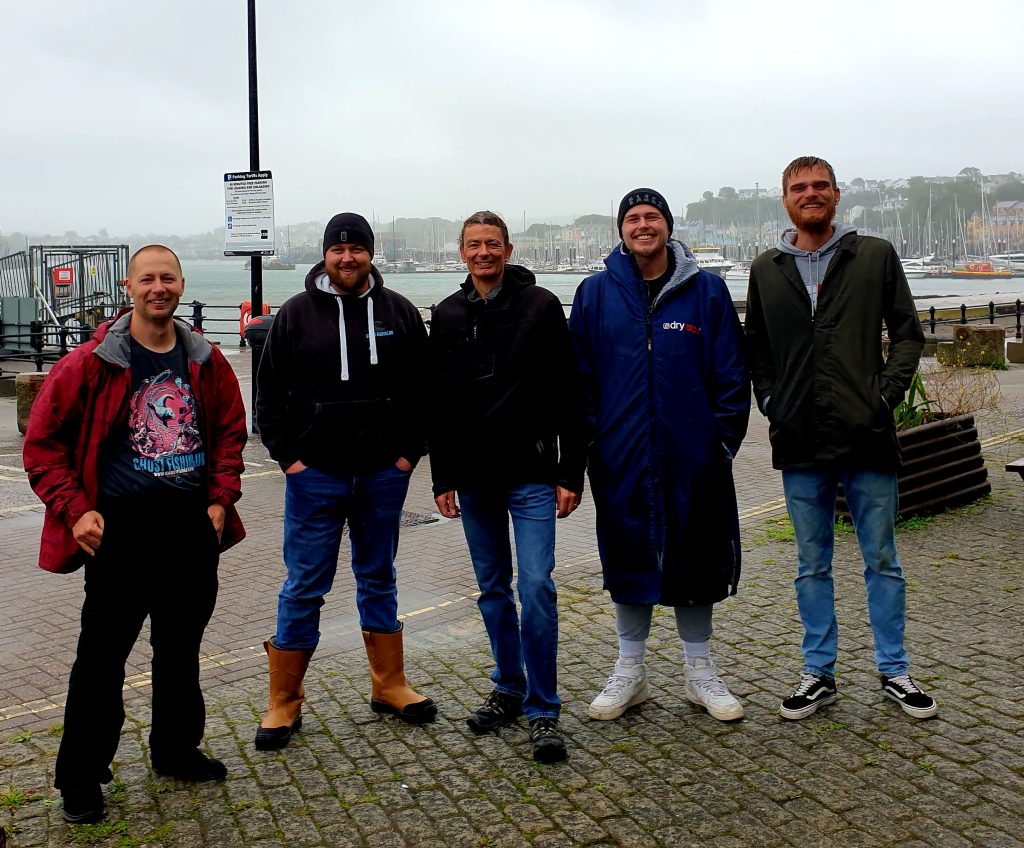
The team, taken by the author. Image: Andrea Brown
| Diver profile: Andrea Brown | |
I have always had a love of water and a fascination with the ocean stemming from when my father used to take me sailing as a young girl. I always wanted to see what was under the surface and I started diving 30 years ago (eek!) as part of a BSAC club. After a few years I became a PADI instructor and worked in Menorca for two years, before moving back to the UK and my BSAC club. Following a trip to Scapa, I got interested in the more technical side of diving and started my GUE training in 2002 with Cave 1 in Florida (back in the day when Fundamentals was not mandatory, although I did go on to do it later). I now have a bunch of GUE qualifications (to go with the BSAC, PADI and IANTD qualifications), with my ‘highest’ being GUE Cave DPV. I first heard of Ghost Fishing UK a few years ago when it was being set up by Richard, Christine and Fred, and I have always admired what the charity stands for. But I didn’t get directly involved as I was concerned about having enough free time to be able to contribute. That changed recently when discussing things with Matt and Jonna Fry (both of whom have been my friends for 20+ years and they have taken part in recovery missions), so I (along with my husband) decided to take the plunge! My favourite diving is in the caves of Mexico, where I was lucky enough to spend three months cave diving from April to June 2022, racking up just under a hundred dives whilst there (cave dives tend to only be one a day as they are usually around four hours long!). |
Glossary
Back kick – frustrating finkick that when mastered allows the diver to swim backwards and look awesome.
Buckie pot – shellfish cage trap used for catching whelks.
Cylinder – steel or aluminium pressure vessel that holds gas at high pressure. Called a ‘tank’ in the USA and elsewhere.
Delayed surface marker buoy – inflatable nylon bag that when filled with air underwater provides a means of communicating with the surface.
Twinset – two breathing gas cylinders manifolded together. Called ‘doubles’ in the USA and elsewhere.
Finning – underwater propulsion using rubber fins attached to the diver’s feet.
Flutter kick – finkick that allows the diver to move forward at speed.
Gas – material stored in the cylinder for the diver to breath, or to inflate lifting bags.
Goodie bag – net bag used to collect small items (goodies) underwater.
Helicopter turn – finkick that when mastered allows the diver to turn on a sixpence.
Inkwell pot – shellfish cage trap shaped like an inkwell.
Lifting bag – inflatable nylon bag that when filled with air underwater provided positive buoyancy in order to lift objects from the seabed.
Lobster pot – shellfish cage trap used for catching crustaceans such as lobsters.
Safety stop – pause at a depth of six metres before the final slow ascent to the surface.
Shotline – rope with a bouy on one end and a grappling hook or weight on the other. Used to provide a reference for divers. Called a ‘downline’ in the USA and elsewhere.
Stage cylinder – aluminium pressure vessel that holds gas at high pressure and is held on the side of the diver. Used to carry air to inflate lifting bags on Ghost Fishing UK dives.
Surface interval – required period of time between dives for cups of tea and slices of cake.
Out-of-gas drill/ascent – skill taught to scuba divers as an emergency procedure in the event of a loss of breathing gas. Sometimes called an S-drill or AS Ascent.

